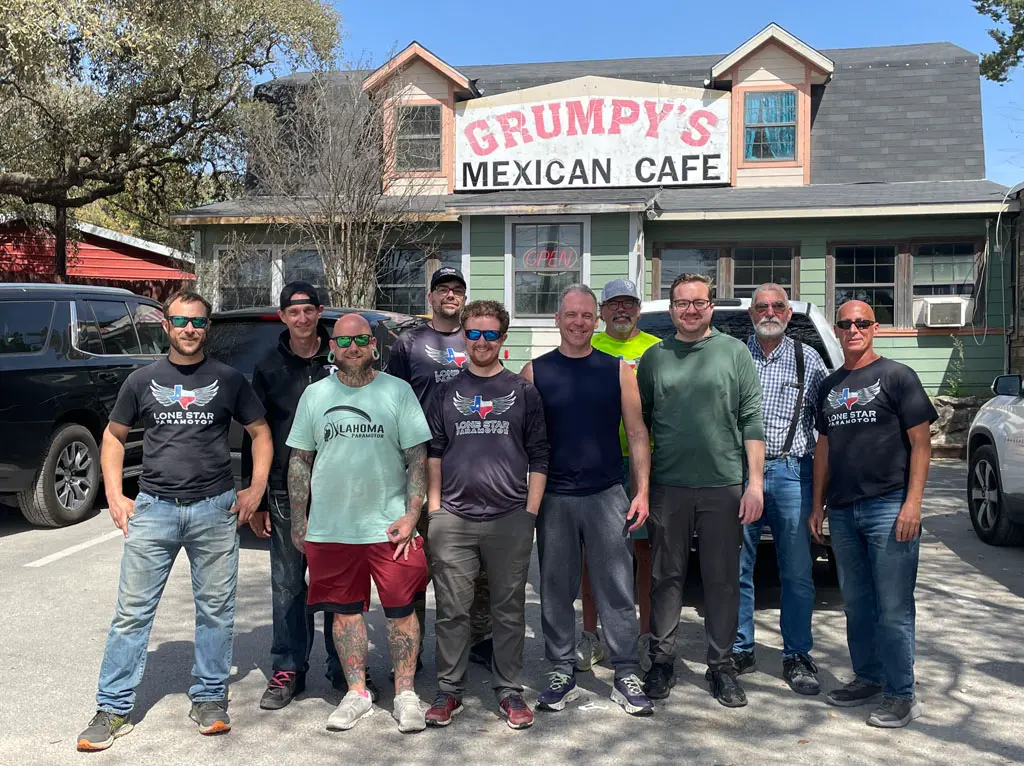Select below from Training, Equipment or a Discovery Flight!
Soar to New Heights
Welcome to
Lone Star Paramotor
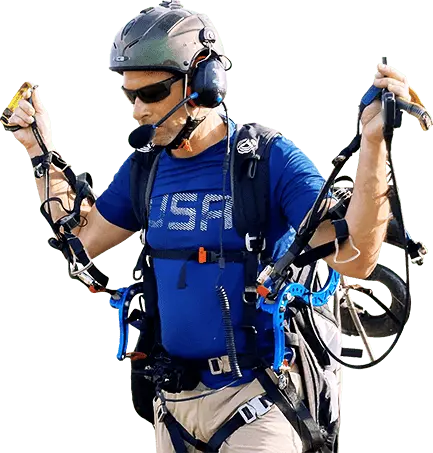
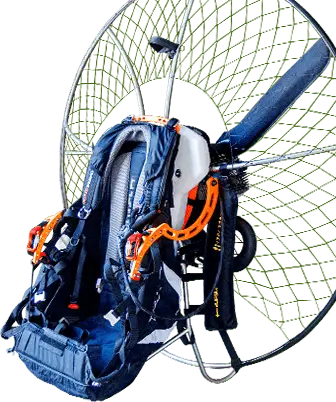
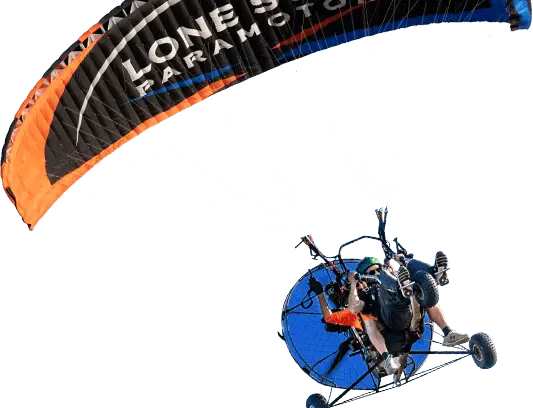
Welcome to
Lone Star Paramotor
Soar to New Heights
Are you ready to hit the open skies and fly to new heights? Lone Star Paramotor is here to help you turn your dreams into reality! Our mission is to help you gain the freedom to achieve more in life. Experience your dreams of flight and embrace the amazing adventure that awaits with our passionate flight team.
We Offer Flight Opportunities for Everyone:
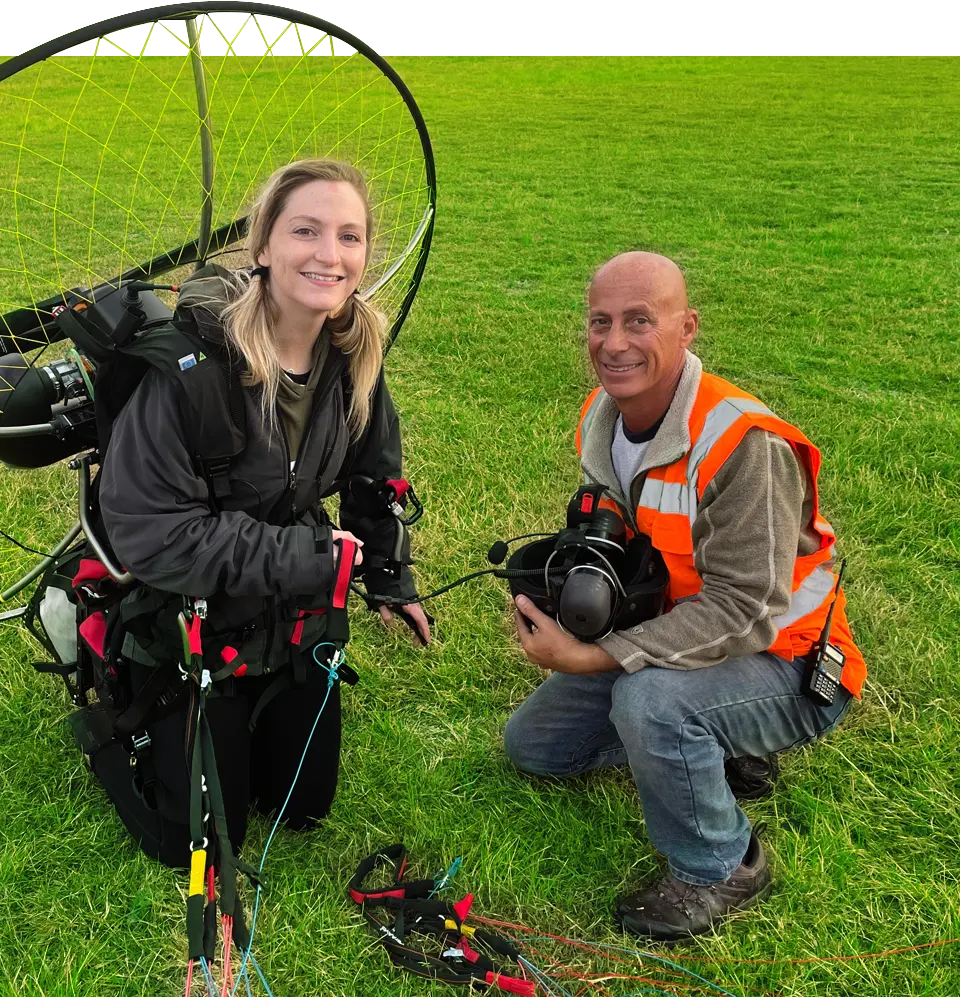
Get Off the
Ground and Enjoy the
Experience with Us
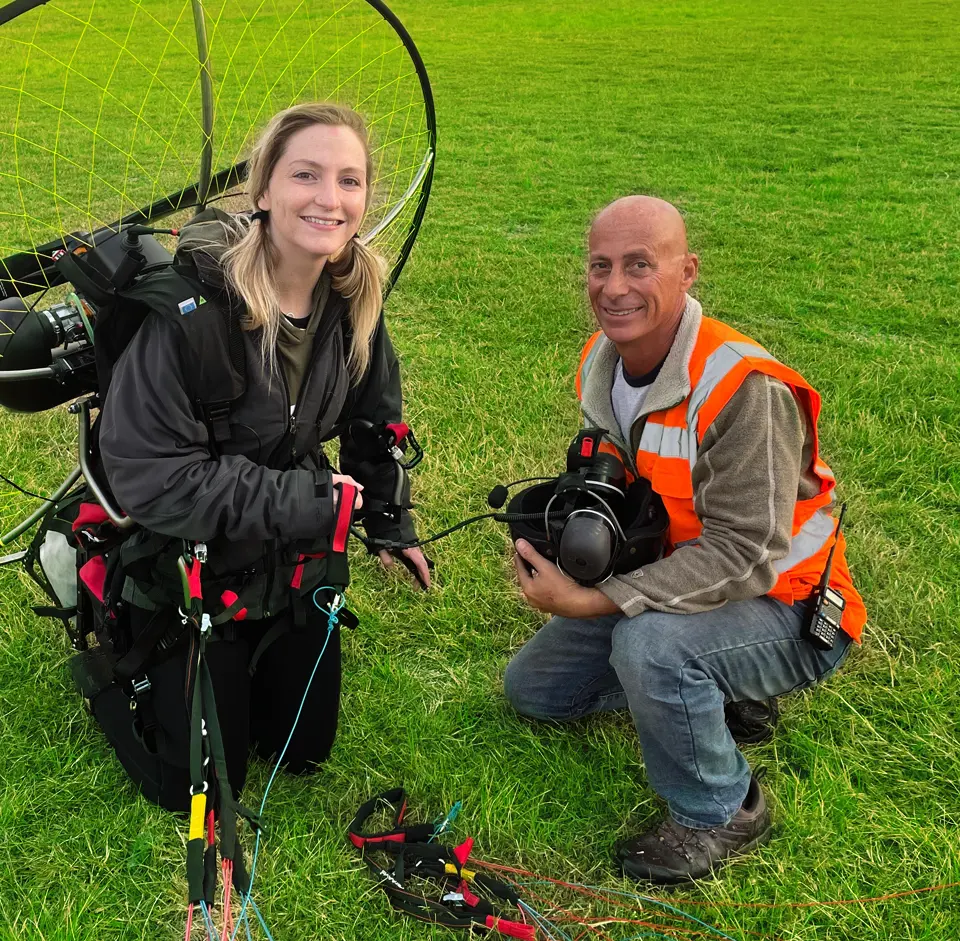
Hey, I’m Ron! I started Lone Star Paramotor to deliver quality training programs pilots need to perfect their flight skills. At Lone Star Paramotor, we offer a complete curriculum that teaches the comprehensive knowledge and skills you need to fly with confidence and safety on your own.
Whether you come to our school without previous experience or are looking to expand, refine, and advance your skills, we have the training and programs to help! We’ve helped hundreds of paramotor pilots achieve their flight goals, and we’re excited to help you achieve yours!
Training Videos

Chasing Good Weather!

What's a Discovery Flight?
Why Choose
Lone Star Paramotor?
Do you want to learn how to fly in a
safe and controlled environment?
Lone Star Paramotor is here to help you turn your dreams into reality!
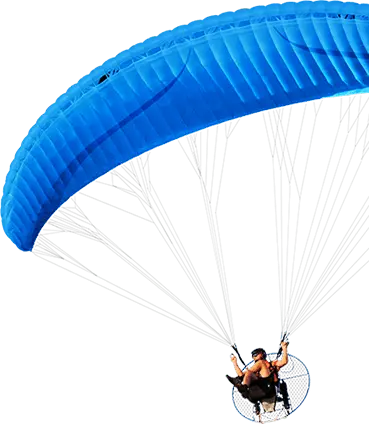
Frequently Asked Questions
Paramotoring goes by a few different names interchangeably including paramotoring, powered paragliding, and ppg. It is the motored (powered) version of paragliding where a pilot sits seated in a harness suspended under a canopy (aka wing or paraglider) and is propelled by a propellor driven motor. Paramotors come in two versions; a backpack unit called a foot-launch paramotor and a wheel-launch version sometimes called a trike. A paramotor is defined as an “ultralight vehicle” by the Federal Aviation Administration (FAA).
Most paramotor flight is done in nice weather conditions. Stable winds below 10mph make for the best flying and generally occur within a 2-3 hour daylight window around sunrise and sunset. Many locations in the US will regularly have 3 flying days a week where some may even have 6+. Other locations will only be able to fly seasonally. Paramotors can be flown during the twilight periods 30 minutes before official sunrise and 30 minutes after official sunset if equipped with an anticollision light (strobe) that can be seen for at least 3 statute miles.
Yes and no. In order for a paramotor to qualify as an Ultralight Vehicle under the FAA regulations, equipment is limited to single occupancy. After gaining experience as a paramotor pilot, a pilot can apply for ratings and complete further training which will allow them to obtain a waiver called a “tandem exemption.” This waiver allows certified pilots to take a single passenger up on flights for non-commercial instructional purposes. Currently the two organizations that tandem certification can be obtained through are the USPPA and the ASC. In both of these organizations, pilot proficiency must be proved and instructor certificates obtained before the pilot has reached the level where they can then be trained for a tandem exemption.
Getting into paramotoring would be similar in cost as getting a motorcycle. Up front costs including gear and training can range from $5,000 to upwards of $15,000. As with all activities, there is a considerable range of options that can suit many different types of pilot needs and budget. Once a new pilot has their gear and is proficiently flying, the ongoing costs are relatively low. Both motor and glider wing are capable of flying for hundreds of hours with proper care. Most training programs provide gear for students to learn on and offer education to assist new pilots in determining which gear will work best for their individual size, weight, flying regions, desired type of flight, skill, and more.
Paramotors can be launched from most open pieces of flat land. With high skill, pilots can successfully launch and land from much smaller areas. Paramotors can be flown in uncontrolled airspace (Class G and most Class E airspace) and cannot be flown over congested areas of people or restricted areas. Additional areas may be off-limits in the event of a Temporary Flight Restriction (TFR) as noted in a Notice to Airmen (NOTAM). In the United States, paramotors are allowed to fly up to 18,000 feet due to airspace restrictions. Outside of the US, pilots have made records of flight over 25,000 feet. Most pilots tend to enjoy flying between 300-1,000 feet where the freedom to explore is best experienced. A thorough training program should teach pilots how identify safe and legal areas to fly.
No. Paramotor pilots are regulated by FAA Federal Aviation Regulation 103 for Ultralight Vehicles. As long as a paramotor pilot abides by these regulations, they are allowed to fly without needing a medical certificate, pilot license, training, or registration. A quality training program will ensure a new pilot obtains both the physical skills required and also the necessary knowledge on weather, regulations, airspace, safety, and more.
Length of flight will depend on the specific equipment's fuel capacity (5 gallons max in the US) and the efficiency of flight. Most foot launch paramotor configurations have the capacity to fly 3 or more hours when fully fueled and at moderate throttle. Typical paramotor flights last between 20 minutes and one hour but with full fuel and the right thermal and lift conditions, flight could be extended by several hours.
We still have training options to suit your needs! Give us a call so we can coordinate a schedule that will work best for you.
Texas is one of the few areas in the US that experiences favorable flying conditions year-round. Unfortunately, weather can be unpredictable and may hinder training progress. In the case of inclement weather, most times, we are able to rearrange the class units to cover ground school during the poor conditions and take advantage of the windows of good weather to learn skills that require us to be outside. If bad weather persists, the students and instructors will discuss the possibility of flying at alternate locations during training. Other arrangements may be made on a case by case basis. Each beginner training class includes 6-months of additional instruction support that allows students to continue to take advantage of good weather and get more flights in until they reach a solo pilot level of confidence.
We understand that not everyone is able to accommodate a ten day block of time away from their other obligations like work and family. We have had students in the past spread out their training to weekends and evenings when the weather and their schedule cooperates. These students typically take longer to develop their skills since during the gaps in their training, there will be a bit of skill atrophy. Don’t let this discourage you though! Give us a call so we can make a training plan that will fit your schedule.
A $500 non-refundable deposit reserves your spot during your selected training dates, the remaining balance is due 30 days before the selected training class and is also non refundable.
If a scheduling conflict arises, the $500 deposit may be transferred to a future training class if LSP is notified at least 30 days prior to the start of the selected course. If a conflict arises after the remaining training balance is due within the 30 day window before class, it is unlikely that Lone Star will be able to fill that reserved spot in such short notice. A student may be able to reschedule to an alternate available training slot.
Yes! We offer a $200 military discount for active duty and veterans. We also offer a discount of $200 per person for groups of 3 or more that reserve training slots in the same class.
Texas is one of the few areas in the US that experiences favorable flying conditions year-round. Unfortunately, weather can be unpredictable and may hinder training progress. In the case of inclement weather, most times, we are able to rearrange the class units to cover ground school during the poor conditions. If bad weather persists, the students and instructors will discuss the possibility of flying at alternate locations during training. Other arrangements may be made on a case by case basis.
Our confidence builder classes do not include rental equipment. For pilots that have their own equipment, it is best to complete this training on the equipment you will ultimately be flying on your own in order to develop confidence on your specific gear. If you do not have a helmet with communications capabilities for an instructor to communicate with you over a radio, Lone Star Paramotor will provide one for you. Wings and motor units may be rented for an additional fee.
- General
-
What is paramotoring?
Paramotoring goes by a few different names interchangeably including paramotoring, powered paragliding, and ppg. It is the motored (powered) version of paragliding where a pilot sits seated in a harness suspended under a canopy (aka wing or paraglider) and is propelled by a propellor driven motor. Paramotors come in two versions; a backpack unit called a foot-launch paramotor and a wheel-launch version sometimes called a trike. A paramotor is defined as an “ultralight vehicle” by the Federal Aviation Administration (FAA).
When can a paramotor be flown?Most paramotor flight is done in nice weather conditions. Stable winds below 10mph make for the best flying and generally occur within a 2-3 hour daylight window around sunrise and sunset. Many locations in the US will regularly have 3 flying days a week where some may even have 6+. Other locations will only be able to fly seasonally. Paramotors can be flown during the twilight periods 30 minutes before official sunrise and 30 minutes after official sunset if equipped with an anticollision light (strobe) that can be seen for at least 3 statute miles.
Can pilots take up passengers when flying a paramotor?Yes and no. In order for a paramotor to qualify as an Ultralight Vehicle under the FAA regulations, equipment is limited to single occupancy. After gaining experience as a paramotor pilot, a pilot can apply for ratings and complete further training which will allow them to obtain a waiver called a “tandem exemption.” This waiver allows certified pilots to take a single passenger up on flights for non-commercial instructional purposes. Currently the two organizations that tandem certification can be obtained through are the USPPA and the ASC. In both of these organizations, pilot proficiency must be proved and instructor certificates obtained before the pilot has reached the level where they can then be trained for a tandem exemption.
How much does paramotoring cost?Getting into paramotoring would be similar in cost as getting a motorcycle. Up front costs including gear and training can range from $5,000 to upwards of $15,000. As with all activities, there is a considerable range of options that can suit many different types of pilot needs and budget. Once a new pilot has their gear and is proficiently flying, the ongoing costs are relatively low. Both motor and glider wing are capable of flying for hundreds of hours with proper care. Most training programs provide gear for students to learn on and offer education to assist new pilots in determining which gear will work best for their individual size, weight, flying regions, desired type of flight, skill, and more.
Where can you fly a paramotor?Paramotors can be launched from most open pieces of flat land. With high skill, pilots can successfully launch and land from much smaller areas. Paramotors can be flown in uncontrolled airspace (Class G and most Class E airspace) and cannot be flown over congested areas of people or restricted areas. Additional areas may be off-limits in the event of a Temporary Flight Restriction (TFR) as noted in a Notice to Airmen (NOTAM). In the United States, paramotors are allowed to fly up to 18,000 feet due to airspace restrictions. Outside of the US, pilots have made records of flight over 25,000 feet. Most pilots tend to enjoy flying between 300-1,000 feet where the freedom to explore is best experienced. A thorough training program should teach pilots how identify safe and legal areas to fly.
Is a license or certification required to fly a paramotor?No. Paramotor pilots are regulated by FAA Federal Aviation Regulation 103 for Ultralight Vehicles. As long as a paramotor pilot abides by these regulations, they are allowed to fly without needing a medical certificate, pilot license, training, or registration. A quality training program will ensure a new pilot obtains both the physical skills required and also the necessary knowledge on weather, regulations, airspace, safety, and more.
How long can a paramotor fly?Length of flight will depend on the specific equipment's fuel capacity (5 gallons max in the US) and the efficiency of flight. Most foot launch paramotor configurations have the capacity to fly 3 or more hours when fully fueled and at moderate throttle. Typical paramotor flights last between 20 minutes and one hour but with full fuel and the right thermal and lift conditions, flight could be extended by several hours.
- Beginner pilot traing
-
What if I’m unable to join one of the 10 day classes?
We still have training options to suit your needs! Give us a call so we can coordinate a schedule that will work best for you.
What if the weather is bad during training?Texas is one of the few areas in the US that experiences favorable flying conditions year-round. Unfortunately, weather can be unpredictable and may hinder training progress. In the case of inclement weather, most times, we are able to rearrange the class units to cover ground school during the poor conditions and take advantage of the windows of good weather to learn skills that require us to be outside. If bad weather persists, the students and instructors will discuss the possibility of flying at alternate locations during training. Other arrangements may be made on a case by case basis. Each beginner training class includes 6-months of additional instruction support that allows students to continue to take advantage of good weather and get more flights in until they reach a solo pilot level of confidence.
What if I’m unable to attend a full 10 day class?We understand that not everyone is able to accommodate a ten day block of time away from their other obligations like work and family. We have had students in the past spread out their training to weekends and evenings when the weather and their schedule cooperates. These students typically take longer to develop their skills since during the gaps in their training, there will be a bit of skill atrophy. Don’t let this discourage you though! Give us a call so we can make a training plan that will fit your schedule.
What is the refund policy for training fees?A $500 non-refundable deposit reserves your spot during your selected training dates, the remaining balance is due 30 days before the selected training class and is also non refundable.
If a scheduling conflict arises, the $500 deposit may be transferred to a future training class if LSP is notified at least 30 days prior to the start of the selected course. If a conflict arises after the remaining training balance is due within the 30 day window before class, it is unlikely that Lone Star will be able to fill that reserved spot in such short notice. A student may be able to reschedule to an alternate available training slot.
Do you offer any training discounts?Yes! We offer a $200 military discount for active duty and veterans. We also offer a discount of $200 per person for groups of 3 or more that reserve training slots in the same class.
- Confidence Builder Training
-
What if the weather is bad during training?
Texas is one of the few areas in the US that experiences favorable flying conditions year-round. Unfortunately, weather can be unpredictable and may hinder training progress. In the case of inclement weather, most times, we are able to rearrange the class units to cover ground school during the poor conditions. If bad weather persists, the students and instructors will discuss the possibility of flying at alternate locations during training. Other arrangements may be made on a case by case basis.
What if I don’t have all of my own gear?Our confidence builder classes do not include rental equipment. For pilots that have their own equipment, it is best to complete this training on the equipment you will ultimately be flying on your own in order to develop confidence on your specific gear. If you do not have a helmet with communications capabilities for an instructor to communicate with you over a radio, Lone Star Paramotor will provide one for you. Wings and motor units may be rented for an additional fee.
For more questions regarding training and pricing, please contact us.
March 2025 Powered Paragliding Class: Images & Clips
Relive the excitement of our March 2025 paramotor training course through photos and videos of student flights, hands-on lessons, and unforgettable first launches. See what it’s like to learn powered paragliding with Lone Star Paramotor.



